Basil is a versatile and delicious herb that is easy to grow at home. By growing your own basil, you can have a fresh supply of leaves at your fingertips. There are many different varieties of basil to choose from, each with its own unique flavor and aroma. Basil is a low-maintenance plant and can be grown from seed, making it a great choice for beginner gardeners. It can be grown in raised beds, containers, or even in sunny windowsills.
The life expectancy of basil depends on your climate. In colder climates, basil is treated as an annual and needs to be replanted each season. In warmer climates, basil can be grown outdoors for several years. Basil is different from other herbs in the mint family as it is quick and easy to grow from seed.
Basil thrives in warm and sunny conditions, with at least 6 hours of direct sunlight a day. It can also be grown indoors under grow lights. When it comes to watering, basil prefers consistent but not excessive watering. It is important to ensure proper drainage to prevent root rot.
To grow basil, it is best to use sandy, well-drained soil. Amending the native soil with coarse sand and compost can improve drainage and provide necessary nutrients. If growing in containers, a mix of organic potting soil, coarse sand, and compost is recommended. Regular feeding with a water-soluble plant food can promote excellent leaf production.
Harvesting basil leaves can be done at any time once the plants reach a height of 6 to 8 inches. Pinching off the topmost branches encourages more side shoots and a taller plant overall. Basil leaves can be used fresh in a variety of dishes or preserved by freezing or using them in vinegar. It is important to harvest basil before the first frost as the plants will quickly turn black in cold weather.
Key Takeaways:
- Basil is a delicious and versatile herb that is easy to grow at home.
- Basil can be grown from seed, making it a great choice for beginner gardeners.
- Basil thrives in warm and sunny conditions, with at least 6 hours of direct sunlight a day.
- Harvesting basil leaves can be done at any time once the plants reach a height of 6 to 8 inches.
- Growing a basil garden is a great way to have fresh herbs at your fingertips.
Easy Steps to Grow Basil from Seed
Basil is easy to grow from seed and can be grown in raised beds, containers, or sunny windowsills. There are many different varieties of basil to choose from, each with its own unique flavor and aroma. Whether you are a seasoned gardener or a beginner, growing basil can be a rewarding experience that requires little effort.
The first step to growing basil from seed is to determine the best time to plant based on your local frost dates. Since basil loves long and warm days, it requires plenty of sunlight to thrive. It is recommended to provide 6 or more hours of direct sunlight per day for optimal growth. Basil also prefers moist but well-drained soil, so make sure to water consistently and avoid overwatering.
To plant basil seeds, start by preparing the soil by amending it with compost or organic matter. Basil seeds can be sown directly into the soil, about ¼ inch deep and 12 to 18 inches apart. Once the seeds are planted, water thoroughly and keep the soil moist until the seedlings emerge.
As the basil plants grow, it is important to pinch off the topmost branches to promote more side shoots and overall plant growth. Regular pruning will prevent the plants from flowering and going to seed, allowing for a continuous harvest of leaves. Harvesting can begin when the plants reach a height of 6 to 8 inches, and leaves can be pinched off as needed.
Basil can be grown both indoors and outdoors. If growing basil indoors, make sure to place the plants in south- or east-facing windows to maximize sunlight exposure. Alternatively, grow lights can be used to provide the necessary light for indoor basil plants.
In terms of care and maintenance, basil may be susceptible to pests such as aphids, slugs, and Japanese beetles. Proper drainage is key to prevent root rot, so ensure that the soil is well-drained. Fertilize regularly with a water-soluble plant food to support leaf production and overall plant health.
Harvested basil leaves can be used fresh in a variety of dishes, including sauces, salads, and pasta. They can also be preserved by freezing or using them in vinegar or oils. To extend the lifespan of cut stems, place them in water to keep them fresh.
By following these easy steps, you can enjoy a bountiful supply of fresh basil leaves right at home. Avoid the expense of buying pre-packaged herbs and have the satisfaction of growing your own delicious and aromatic basil.
Understanding Basil’s Growing Habits
Basil is a versatile herb that can easily be grown at home. It comes in various flavors, aromas, and appearances, making it a great choice for those interested in experiencing different types of basil. Basil is a low-maintenance plant that grows prolifically, and the more leaves you cut, the more it will produce. It can be grown in raised beds, containers, pollinator gardens, or sunny windowsills.
The growing season for basil depends on the climate. In colder climates, basil cannot survive the fall/winter season, so it is treated as an annual and new basil plants are grown each warm season. However, in warmer climates, basil can be grown outdoors for several years. Basil is different from other herbs in the mint family as it is easy and quick to grow from seed. If basil flowers and drops seeds, new basil plants will grow from those seeds in the next growing season.
Basil thrives in long and warm days, making it important to consider day length when planting. It can handle heat but benefits from some afternoon shade when temperatures rise above 90°F. Knowing the frost dates in your area is crucial in determining when to grow basil. The longer the time between the last spring frost and the first fall/winter frost, the more time you have to enjoy fresh basil leaves.
Basil requires a lot of sunlight and should ideally receive 6 or more hours of direct sun. It can be grown indoors under grow lights or in south- and east-facing windows. When it comes to watering, basil prefers consistent but not excessive water. It’s important to provide good drainage to prevent the roots from sitting in water for too long. The water requirements may vary depending on the size of the container or pot.
Basil thrives in sandy, well-drained soil and can be grown in raised beds or containers. Adding coarse sand and compost to the soil will improve drainage and provide important nutrients. When growing basil, it is recommended to use organic potting soil, coarse sand, and compost in equal parts. Regular feeding with a water-soluble plant food is also essential for excellent leaf production.
To harvest basil leaves, pinch them off from the top of the plant. Regular pruning and removing blooms will encourage the plant to branch and produce more leaves. When the first frost is predicted, it is best to harvest all basil leaves as they will quickly turn black in cold weather. Basil leaves can be dried, frozen, or used in various dishes such as tomato dishes, soups, salads, sauces, and pasta.
Overall, understanding basil’s growing habits will help gardeners successfully grow this versatile herb and enjoy its fresh leaves throughout the growing season.
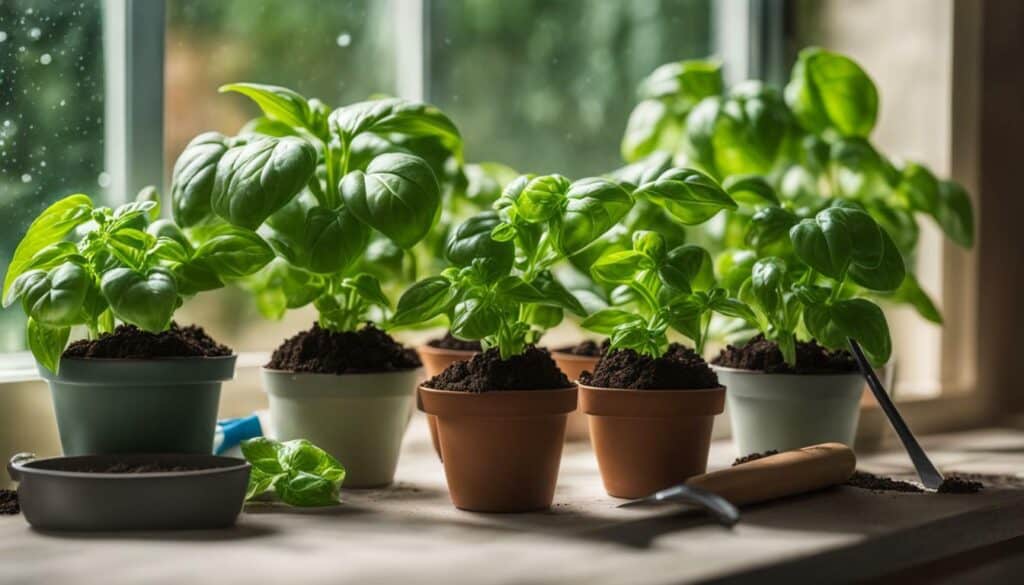
Best Time and Conditions to Grow Basil
The best time to grow basil is during the warmer months, when it can take advantage of long and warm days. Basil is a warm-weather annual that thrives in temperatures ranging from 80 to 90 degrees Fahrenheit. For optimal growth, it is recommended to plant basil two weeks after the last spring frost.
Basil needs at least 6 to 8 hours of direct sunlight a day to grow strong and healthy, although it can survive with 4 hours. Therefore, it is best to choose a location for your basil garden that receives plenty of sunlight. It is also important to ensure that the soil is moist but well-drained, as basil prefers sandy soil. Water your basil plants deeply whenever the top inch of soil becomes dry, but be careful not to overwater as this can lead to root rot.
In addition, basil benefits from the addition of compost. Regular fertilizing is also recommended, especially if you plan to harvest your basil heavily. For bushier plants, pinch off the topmost branches of your basil plant to encourage side shoots and taller growth.
The ideal time to harvest basil leaves is once the plants reach a height of 6 to 8 inches. It is important to harvest your basil before the first predicted frost, as basil quickly turns black in cold weather. You can store harvested basil by drying it, freezing it, or using it to flavor oils and pesto. By paying attention to the best time and conditions, you can successfully grow a basil garden and enjoy fresh herbs all season long.
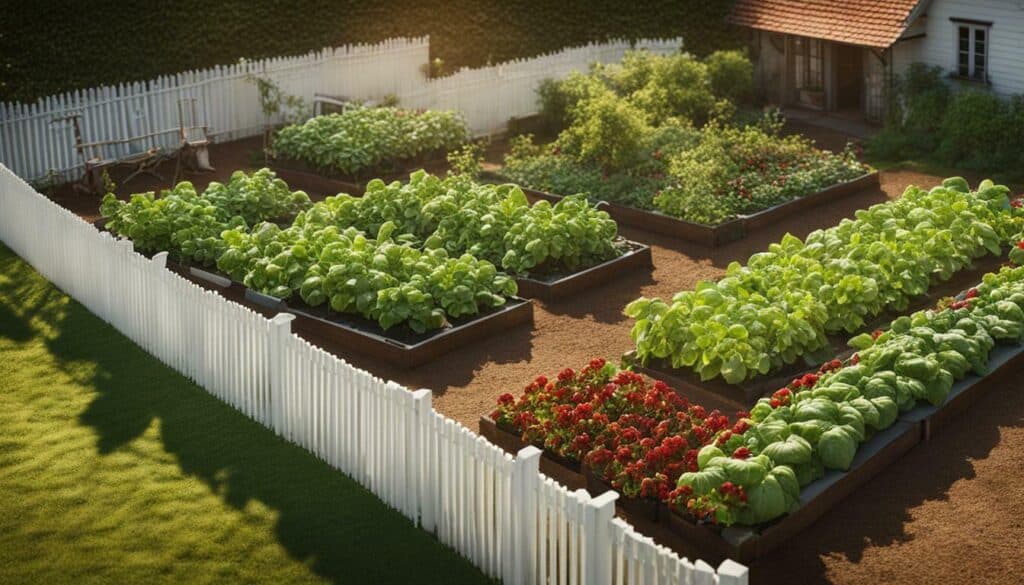
Watering and Harvesting Basil
Basil requires 6-8 hours of sunlight a day and prefers well-drained soil. To ensure healthy growth, it is recommended to water basil consistently, but not excessively. Water the plant when the top inch of soil becomes dry and avoid overwatering, as basil roots can rot if they sit in water for too long.
If you are planting basil in a container or herb planter, make sure it is deep enough to accommodate the plant’s roots and has drainage holes at the bottom to allow excess water to escape.
Basil leaves can be harvested anytime once the plant reaches 6 to 8 inches in height. To promote more side shoots and a taller plant overall, pinch off the topmost branches of the plant. Pinch off the leaves from the tips of the stems to encourage the plant to branch and produce more leaves.
When harvesting, make sure to take only a few leaves from each stem, and avoid removing more than one-third of the plant at a time, as this can stress the basil and affect its growth.
Basil leaves can be stored by freezing them in an airtight container or using them in vinegars, oils, or pesto. With proper watering and harvesting, you can enjoy a fresh supply of organic basil all year round.
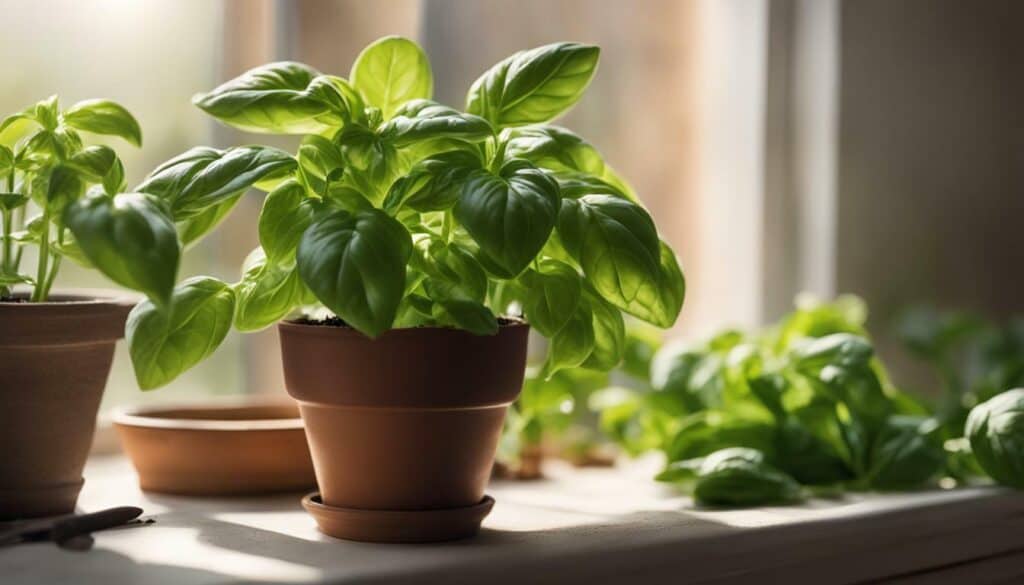
Propagating Basil from Store-Bought Packages
If you want to enjoy fresh basil leaves all year round, there’s an easy and cost-effective way to do it. You can also propagate basil from store-bought packages by placing a stem in water until it develops roots, then planting it in a small pot. This method is perfect for when you want to experiment with different varieties of basil or replace older plants in your herb garden.
To get started, select a package of fresh basil from your local grocery store or farmer’s market. Look for a package with a healthy plant and long stems. Cut a stem about 4-6 inches from the top and remove the lower leaves, leaving only a few leaves at the top.
| Steps to Propagate Basil from Store-Bought Packages: |
|---|
| Step 1: Place the stem in a glass filled with water |
| Step 2: Keep the glass in a warm and bright location, but out of direct sunlight |
| Step 3: Change the water every two to three days to prevent bacteria growth |
| Step 4: Wait for the roots to grow to a length of 2-3 inches |
| Step 5: Fill a small pot with well-draining soil and transplant the basil stem into the pot |
| Step 6: Keep the soil moist and place the pot in a sunny location |
Propagating basil from store-bought packages is a fantastic way to start your basil garden, even if you don’t have the space for a full herb garden. Basil grows well in containers, so you can keep your propagated basil plant indoors on a windowsill or outside on a balcony. Remember to give it plenty of sun and water consistently, but not too much water as that can cause root rot.
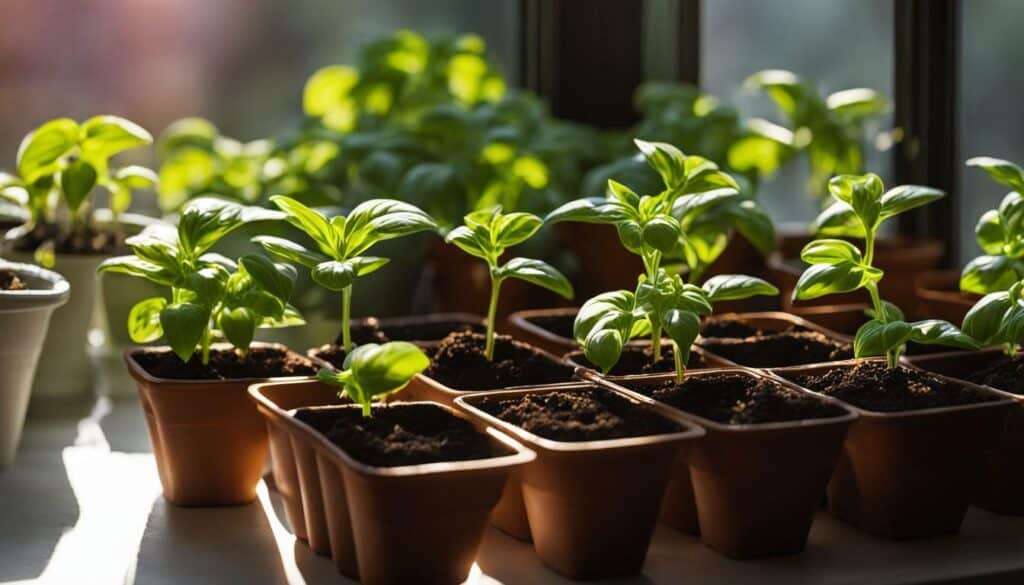
Another benefit of propagating basil from store-bought packages is that it’s an excellent way to save money while enjoying fresh herbs in your cooking. Once your basil plant has grown, you can trim the leaves regularly and use them in a variety of recipes, such as pesto, salads, and pasta dishes. Basil is easy to grow, and with a little care and attention, you can have an endless supply of the herb for free.
Enjoying Basil in Various Dishes
Basil can be used in a variety of dishes and can be stored by freezing or using them in vinegar. It is a versatile herb that can enhance the flavor of many dishes. Its unique flavor and aroma are perfect for adding freshness and vibrancy to salads, soups, sauces, pasta dishes, and more. When cooking with basil, it is best to use the leaves within the last 5 or 10 minutes of cooking to preserve their flavor.
Basil pairs well with other herbs like parsley, rosemary, oregano, thyme, and sage. It can also be used to make pesto, which is a popular Italian sauce made with garlic, pine nuts, Parmesan cheese, and olive oil. Pesto can be used as a pasta sauce, a condiment, or a marinade.
Freezing is a great way to store basil leaves for later use. To freeze basil, wash the leaves, pat them dry, and place them in a single layer on a tray before freezing. Once the leaves are frozen, store them in an airtight container or a freezer bag. Basil can also be used to make flavored vinegar, which is a great way to add flavor to salads and other dishes. To make basil vinegar, simply steep fresh basil leaves in vinegar for several weeks, then strain the mixture and use as desired.
With its vibrant flavor and easy cultivation, basil is a must-have herb for any kitchen. Whether you’re making a fresh pesto, adding it to a tomato sauce, or garnishing a salad, basil is sure to add a pop of flavor to any dish.
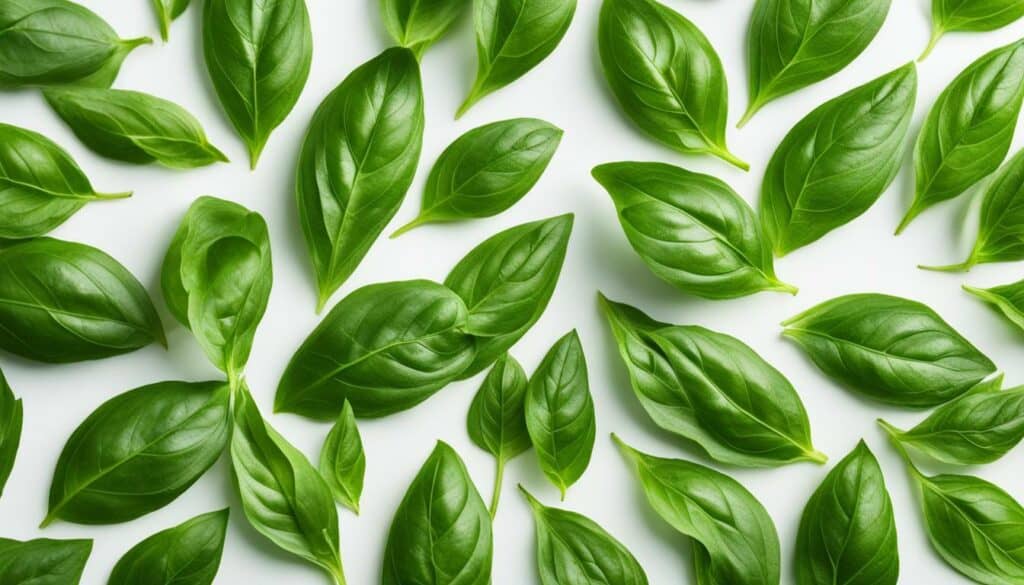
Tips for Year-Round Basil Harvesting
With these tips, you can enjoy fresh basil from your own garden all year round. Basil is a tender perennial herb that requires warm weather and sunlight to thrive. If you live in a colder climate, you can still enjoy fresh basil by treating it as an annual or by growing it indoors.
Basil loves long and warm days, so it grows best in sunny weather around 75 degrees. Therefore, it requires 6-8 hours of direct sunlight daily for optimal growth. Ensure your basil garden is in a location with plenty of sunshine.
It is important to water basil consistently but not excessively. Normally, one inch of water per week is enough, ensuring proper drainage. Basil grows best in sandy, well-drained soil. You can amend the soil with compost or coarse sand for better drainage.
Pinching off the top branches of basil plants promotes more side shoots and overall growth. When basil plants reach a height of 6-8 inches, harvest the leaves by pinching them off. To store the basil leaves, avoid putting them in the fridge because it will turn the leaves brown. Instead, freeze the leaves or use them to flavor oils and pesto.
For year-round harvesting, you can grow basil indoors with proper sunlight or in a hydroponic growing system. When growing indoors, keep the plant near a south-facing window with plenty of sunlight. Other common pests for basil include aphids, slugs, and Japanese beetles. Ensure good drainage to prevent root rot.
Using basil in various dishes can add a lot of flavor to your meals. It can be used in tomato dishes, soups, sauces, and pasta. Its flavor blends well with other herbs like parsley, rosemary, and thyme. Overall, by following these tips, you can enjoy a continuous supply of fresh basil leaves throughout the year.
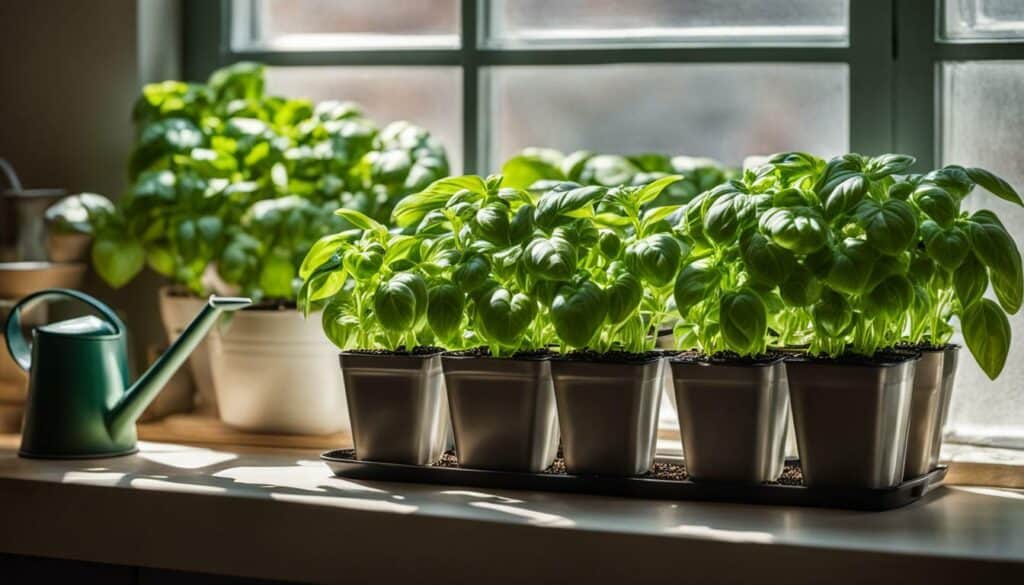
“Basil is one of the most versatile and easy-to-grow herbs around. With a little TLC and some patience, you can enjoy fresh basil anytime you want.”
Benefits of a Basil Garden
Growing your own basil garden offers a range of benefits, including having fresh herbs at your fingertips whenever you need them. Basil is a versatile herb that adds fantastic flavor to dishes and is easy to grow. By having your own basil garden, you can try different varieties of basil and experience their unique flavors, aromas, and appearances. Basil is also an ideal herb for beginners as it is low-maintenance and grows prolifically, providing more leaves when you regularly cut them. It can be grown in various locations, such as in raised beds, containers, or sunny windowsills.
While basil is not a perennial plant, it can thrive in warmer climates and be enjoyed for several years. However, in colder climates, it is treated as an annual and replanted each warm season. The growing season for basil depends on temperature and day length, with basil preferring long and warm days. It requires a minimum of four hours of direct sunlight a day, but six or more hours will result in healthier plants and increased leaf production. Basil also has specific water requirements, needing consistent but not excessive watering. It is essential to provide well-drained soil, whether amending the native soil or using a container, to ensure the optimal growth of basil.
To grow basil successfully, it is recommended to start with strong young plants and space them according to label recommendations. Basil benefits from fertile soil with proper drainage and a pH level between 6.0 and 7.0. Regular feeding with a water-soluble plant food is necessary to support leaf production, considering that basil is heavily harvested for its leaves. Harvesting basil leaves should be done by pinching them off from the top of the plant, which encourages branching and the growth of more leaves. The harvested leaves can be used immediately in various dishes or preserved by freezing or using them in vinegar.
Overall, growing a basil garden provides the advantage of having a fresh and abundant supply of basil leaves throughout the growing season. It allows for the exploration of different basil varieties and cultivates a rewarding gardening experience. Additionally, the cost-saving aspect of growing basil at home eliminates the need to purchase pre-packaged herbs from the store. With proper care and attention, a basil garden can provide an endless supply of this flavorful herb.
Conclusion
In conclusion, growing your own basil garden is a delightful and rewarding experience that provides fresh herbs at your fingertips for a variety of culinary creations. Not only does it save you money, but it also ensures that you have access to organic basil that is free of pesticides and other harmful chemicals.
With its versatility in the kitchen and various types to choose from, basil is a must-have herb for any gardener. It is relatively easy to grow from seed and requires low maintenance, making it suitable for beginners.
The growing season for basil depends on your climate, with warmer regions allowing for several years of growth. Basil thrives in warm and sunny conditions, requiring at least 4-6 hours of direct sunlight daily. It prefers consistent but not excessive watering and well-drained soil.
Harvesting basil leaves should be done regularly by pinching off the topmost branches to encourage more growth. Proper care and pruning will help ensure the longevity of your basil plants.
With these tips in mind, you can enjoy a fresh supply of basil leaves all year round without having to rely on store-bought options. So why not start your own herb garden today and experience the joy and satisfaction of growing your own basil garden!
How Can I Utilize Fresh Basil From My Own Garden?
Maximize basil harvest with garden-fresh recipes by using this versatile herb in various dishes. Infuse basil leaves into olive oil for a flavorful dressing or make pesto to toss with pasta. Try slicing fresh tomatoes, mozzarella, and basil for a refreshing caprese salad. You can also add chopped basil to marinades, soups, and stir-fries, or use it as a garnish. With an abundance of basil from your garden, explore different recipes to fully utilize this fragrant herb.
FAQ
Q: Can I grow basil from seeds?
A: Yes, basil is easy to grow from seed. Simply sow the seeds in well-drained soil and provide them with 6-8 hours of sunlight a day.
Q: When is the best time to grow basil?
A: Basil thrives during the warmer months when it can take advantage of long and warm days. It appreciates the summer weather and grows best during this time.
Q: How often should I water basil?
A: Basil requires consistent watering, but be careful not to overwater. Water the plant when the top inch of soil feels dry to the touch.
Q: How do I harvest basil leaves?
A: To promote more leaf production, regularly harvest basil leaves by pinching them off just above a leaf node. This will encourage new growth.
Q: Can I propagate basil from store-bought packages?
A: Yes, you can propagate basil from store-bought packages. Place a stem in water until it develops roots, then plant it in a small pot. This is an easy way to add more basil plants to your garden.
Source Links
- https://www.eatingwell.com/article/7891537/tiktok-hack-grow-basil/
- https://www.gardenary.com/blog/how-to-grow-your-own-organic-basil-from-seed
- https://bonnieplants.com/blogs/how-to-grow/growing-basil
- https://savvygardening.com/growing-great-basil/
- https://www.tiktok.com/channel/growing-basil
- https://growfully.com/how-to-grow-basil-from-seed/
- https://getbusygardening.com/grow-basil-from-seed/
- https://www.allaboutgardening.com/grow-basil-from-seed/
- https://www.almanac.com/plant/basil
- https://www.juliadimakos.com/a-complete-guide-to-growing-basil/
- https://growinginthegarden.com/how-to-grow-basil-tips-for-growing-basil/
- https://lovelygreens.com/how-to-divide-grocery-store-basil-into-healthy-individual-plants/
- https://www.gardeningknowhow.com/edible/herbs/basil/grocery-store-basil.htm
- https://gardentherapy.ca/fresh-basil-recipes/
- https://savvygardening.com/basil-companion-plants/
- https://www.loveandlemons.com/basil/
- https://www.skh.com/thedirt/basil-101-the-benefits-of-growing-basil/
- https://basmati.com/2016/08/30/basil-you-and-your-garden
- https://www.homestratosphere.com/reasons-to-grow-basil-in-your-garden/
- https://extension.usu.edu/yardandgarden/research/basil-in-the-garden
- https://digitalcommons.usu.edu/cgi/viewcontent.cgi?referer=&httpsredir=1&article=1270&context=extension_curall
- https://peacelovegarden.com/basil-companion-plants/

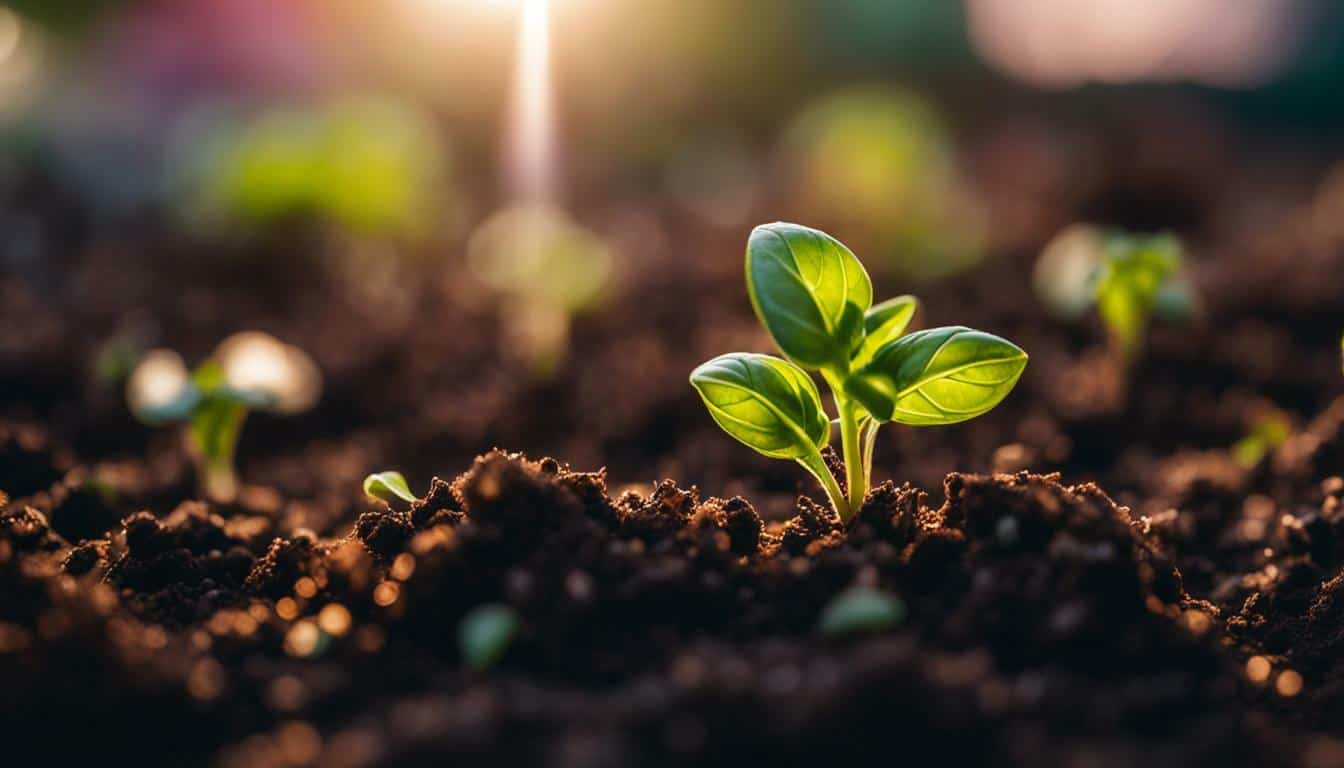



Leave a Reply